Firestone Audio Tobby
Dual chip 192K DAC review
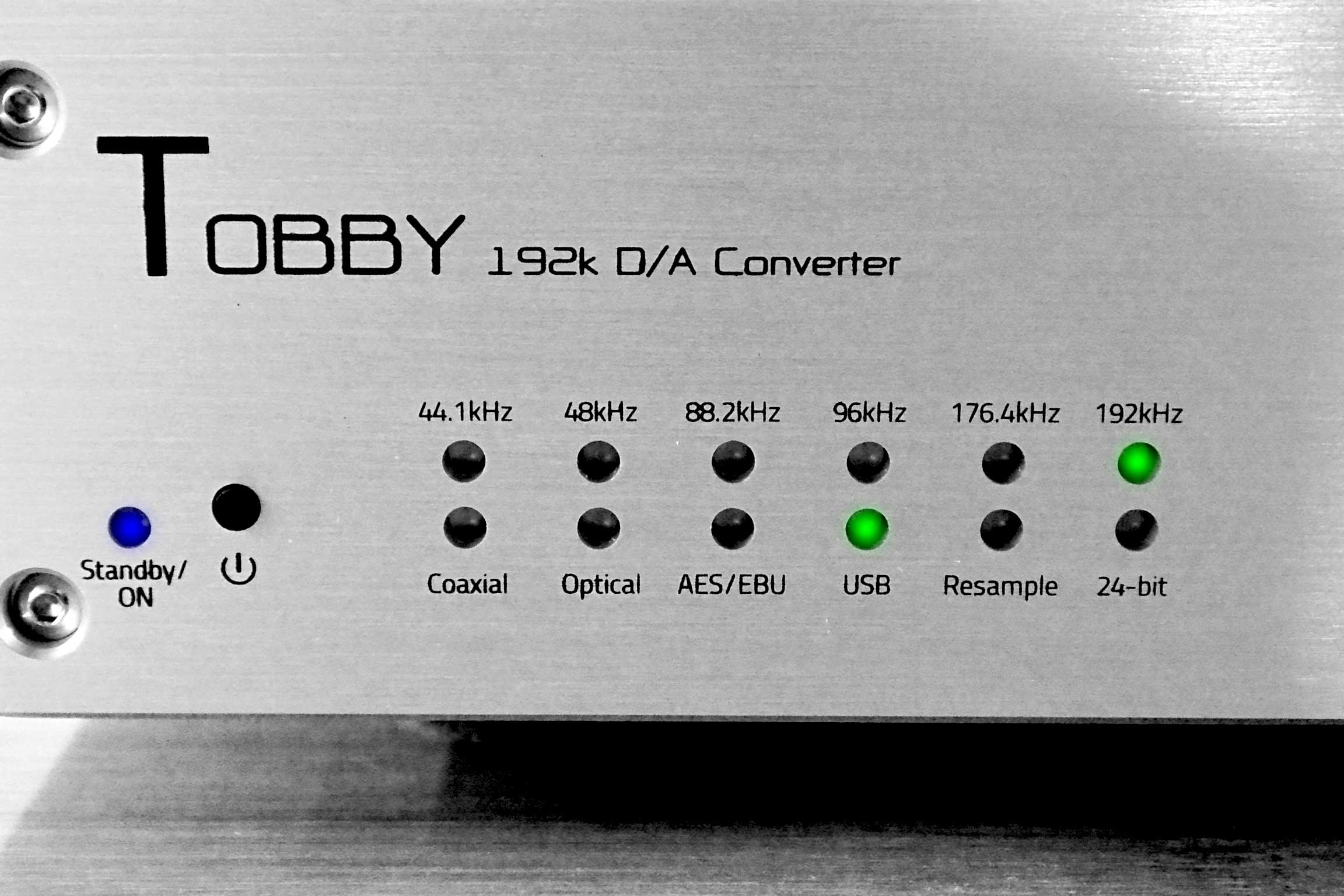

Introduction
Without a doubt we can state: the high fidelity market is like a volcano in full eruption. We are inundated with an endless number of items that have revolutionized, improved and unfortunately also partly leveled the quality of digital audio as we know it.
On the one hand there’s a well defined separation between high priced devices and those of negligible cost on the market, while on the other we can see that the middle range —which is made up of the equipment that can be defined as of average price— has become the most crowded. When we talk about average price, note that we are definitely not referring to mediocre quality as most of the time, regardless of their fairly low cost, you would be surprised by the performance of these objects which would require you to reconsider your convinctions. The average pricing policy associated with high performance seems to belong more to the category of digital to analog converters that are more often an integral part of a dedicated and remarkable reproduction chain. Firestone Audio, a young Taiwanese company, immediately adopted this type of policy often with surprising results from the start. Already in our previous review published here on HDPhonic we were very positively impressed by the performance of their class A balanced headphone amplifier named Bobby, not only for the bang for the buck, but also for the way the amplifeir could drive a demanding headphone such as the Sennheiser HD-650. Today, we are going to try the Tobby that Firestone audio sent to us directly from Taiwan and that is considered the ideal companion for the Bobby. It’s a D/A converter equipped with all kinds of inputs that, at least on paper and according to the commercial policy of Firestone, should raise the bar of sonic quality in this segment of the market.
Design
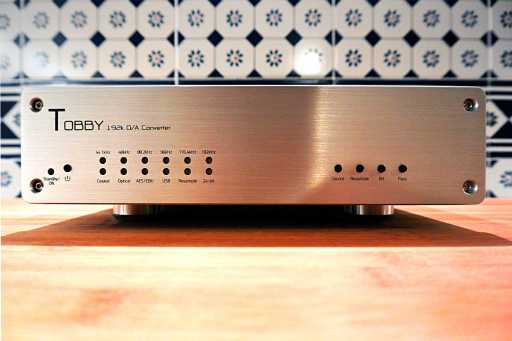
This Firestone Audio DAC is a fairly small sized product, shorter than the Bobby, but one that is fairly heavy given its dimensions. As soon as we got it out of the box, to our amazement, we saw on the back, that the DAC is set up for 115 Volts and therefore not suitable for European voltage standards. However, after a quick exchange of emails with Mr Jacky Wang, head of the technical department of Firestone Audio, late at night due to the different time zones, we figured out how to change the voltage from 115 to 220 Volts. Once we reassembled the exterior chassis we finally turned on the DAC and put it inside our studio without causing any risk of electrical damage. At first glance the Tobby appears externally to be a plain DAC. In fact, there’s a lack of the volume knob control and of the 6.3 mm headphone jack. The front panel is characterized by small buttons and green LED lights. On the right side there is a row of four buttons: Source, Resample, Bit and Pass. The Source button obviously selects the different types of inputs. The Resample button activates the upsampling but in a different way compared to other DACs. In fact, the Tobby allows you to resample the audio signal to any different sampling rate regardless of the frequency of the original source. It’s possible, for example, to convert a native 192 kHz audio signal into 48 kHz and vice versa. The Bit button then re-quantises signal to 24 bit or 16 bit. Finally the Pass button is the abbreviation of passthrough that allows the signal to flow without any kind of alteration of the sampling frequency and the bit depth.
On the left side of the front panel we find, in addition to the power button, a number of green LEDs indicating the sampling frequency of the source and the type of input. A peculiarity of the Tobby, a little bit annoying according to us, is that once turned off the DAC doesn’t keep track of the last selected settings, therefore, every time you switch it back on you’ll have to reselect them manually. On the side panels there are, as on the Bobby, a number of cracks needed to cool the unit, since it’s class A and tends to heat up a fair amount. On the rear panel there are the digital inputs: USB, AES/EBU, S/PDIF and TOSLINK as well as balanced and unbalanced analog outputs. The D/A converter comes complete with the supplied IEC power socket. The Tobby is a dual-mono fully balanced topology DAC. This means that apart from the input stage, it essentially has two of everything: double Burr-Brown PCM1794 DAC, mirrored capacitors, separate steps for the LPF I/V conversion and a trio of op-amp OPA2604 per channel, a relay for each jack and XLR socket. Both channels, while sharing a big single toroidal transformer, have separate regulators. Finally, the conversion from balanced to unbalanced takes place in the final stage, with another OPA2604 and a separate relay. The chip on the USB input is the XMOS XS1 that handles PCM signals up to 192 kHz.
Listening test
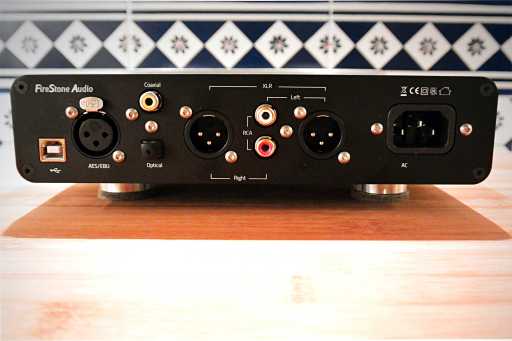
Before carrying out any listening tests we left the DAC playing for a hundred hours and replaced the standard power cord with one designed to our specifications. This is to allow the Tobby to express itself under the best possible conditions in our studio. We can’t deny our great curiosity that accompanied the burn-in phase and our impatience to compare the Firestone Audio DAC with our reference the Violectric V800 —which mounts the Burr-Brown PCM1792 chip and that has an analog output stage with balanced topology— on several different sonic aspects. The dual PCM1794 which equips the Tobby is simply the controlled hardware version of the PCM1792 with similar specifications. On paper, then, at least for the digital section, the sonic performance of the two devices should have many similarities. However, any differences may be due to the type of the USB circuit (Tenor vs. XMOS) or the refinement of the power supply and the analog output stage. We started the listening tests using our high resolution reference songs and we started to compare the two devices using the USB connection with a proper filter and dedicated power supply. What we noticed after several comparisons between one DAC and the other is the fact that the Tobby has a more marked transients articulation and it’s more precise compared to the V800 with a slightly greater extension in both the extreme parts of the sound spectrum. But be careful. We don’t want to define the Tobby as a cold, harsh or rough DAC. Instead, we think that its tone is decidedly more analytical and extended compared to Violectric V800, with a slightly higher level of detail especially on high and medium–low frequencies. The attacks and the release of notes is slightly more accurate on Tobby allowing it to go lower as regards frequency depth. This is most noticeable with electronic music tracks characterized by high frequency extension and articulation.
For genres such as jazz and rock in particular, the Tobby offers a minimal but noticeable faster speed than the Violectric. The soundstage, most likely thanks to the dual-mono configuration, is slightly more open on the Firestone device. The V800, on its part, is a little less detailed and more preponderant, as regards the timbre, on medium-lows and these features make it very slightly warmer and softer when compared to the Tobby. The V800 is a DAC that better interfaces with different audio chains while the product by Firestone Audio prefers systems that require maximum transparency and accuracy over the entire spectrum. Switching to the comparison through the AES/EBU input we didn’t notice any particular differences between one DAC and the other and, in principle, albeit with lower margins, we can confirm the above. This is to emphasize that the Tobby, to give its best, should be mainly used with the USB input, with balanced line connections in order to express its full potential. Regarding the resampling and the bit-depth variation, we found that while getting some benefit, especially in the high frequency range, the differences between a resampled signal and the same signal at the original sampling rate, are not so great as to justify the use of that function. For example, native tracks at 96 kHz didn’t derive particular benefit from being resampled at 192 kHz as well as songs at the audio CD standard. In our opinion, the only setting with which we experienced a slight improvement was the one where we selected a resampling frequency at the same sample rate as the song. In the long run, however, this option may become boring because at every source frequency change you have to manually select it on the DAC. The 24 bit requantization function virtually remained unused in most of our tests. In the end we chose to have the passthrough mode engaged during out listening tests leaving the source unchanged as regards the sample rate and the bit depth.
Final thoughts
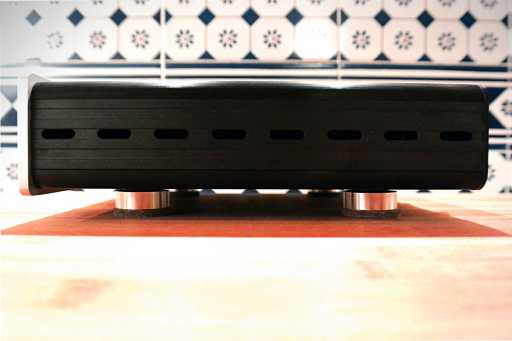
The Tobby DAC is definitely a very well made product. A device that proves the fact that it’s not always necessary to spend a large amount of money in order to have a good sounding D/A converter with various types of digital inputs and great versatility. Purists might still turn up their noses because the Tobby is not capable of decoding formats such as the DSD or the DXD, but for PCM lovers this is definitely a product to hold in high esteem. Within its market segment the Tobby can definitely hold its own. This is also the first product, along with the Bobby, which we feel we could recommend to a beginner that wants to set up a balanced listening system. So don’t be fooled by the price, nor the idea that the Tobby can be considered as a medium product in terms of performance and sound output. So if you’re looking for an excellent DAC, considering the price, we highly recommend buying it.
Personal opinion
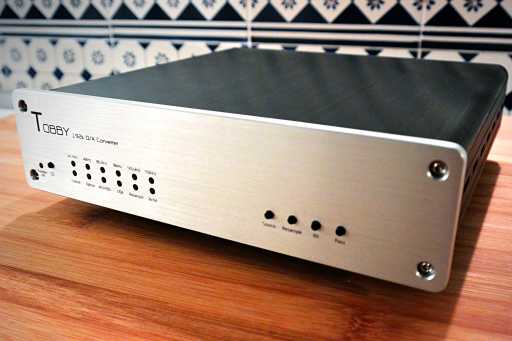
To be honest Tobby’s performance struck me right away and ended up becoming the new DAC reference in our studio. Fast, neutral, analytical, detailed are the adjectives that best suit our new little friend especially when connected through the USB input and in balanced mode. A DAC that can safely be used even in professional enviroments of a high level without fear of performing at a lower level when compared with more expensive products. For now our dear beloved Violectric will retire at least until the new USB card that supports PCM signals up to 192 kHz becomes available. Then the battle will be on again! For the moment: well done Firestone!
Score
- Scoring110
- Sound quality [1]
0 - Bang for the buck [2]
10 - Measures [3]
9 - Build quality [4]
9 - Versatility [5]
9 - Overall rating
9
- 1. The sound quality is extremely good especially with the USB connection
- 2. The bang for the buck of the unit is very high
- 3. A very good linearity of measurements on different parameters
- 4. Build quality and aesthetics are really good
- 5. Versatility is wide-ranging. What a shame about the DSD








